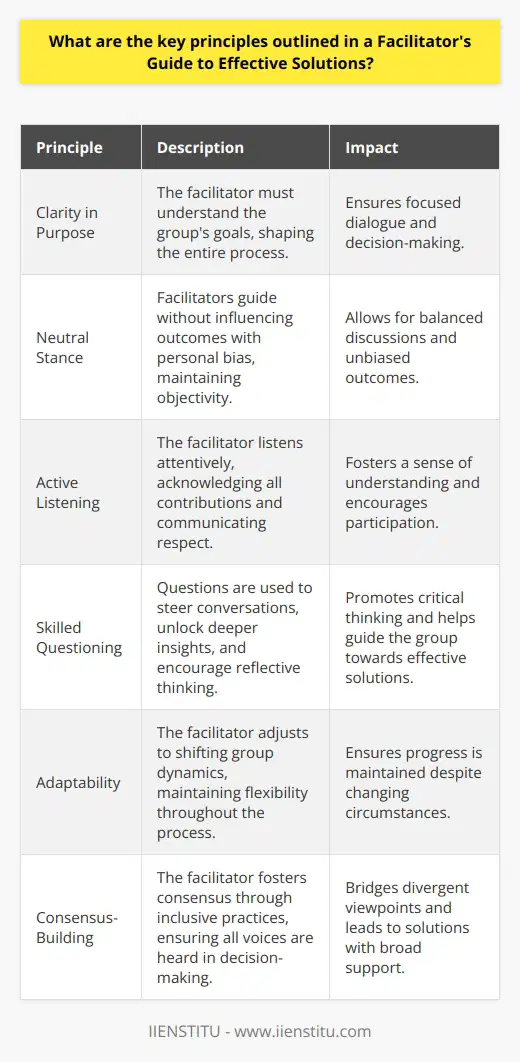
The Art of Facilitation: Guiding Groups Towards Effective Problem-Solving
In the dynamic landscape of group dynamics and problem-solving, facilitation emerges as a pivotal catalyst, propelling collective efforts towards tangible solutions. Diverse organizational contexts necessitate skillful guidance to navigate the intricate tapestry of ideas, perspectives, and potentials that coexist within any group striving for consensus and effective action. This comprehensive guide is meticulously crafted to empower facilitators, equipping them with a robust arsenal of insights and methods to steer their groups towards successful outcomes.
Understanding the Essence of Facilitation
At its core, the role of a facilitator is not to dominate but to elevate group potentials, serving as the bedrock upon which effective solution methods are constructed and realized. Facilitation is an artful amalgamation of leadership and service, wherein the facilitator operates within the group dynamics to cultivate an environment that fosters open communication and productive collaboration. Central to this role is the ability to deftly navigate the intricacies of interpersonal relations while maintaining a unwavering focus on the collective goal.
Key Characteristics of a Successful Facilitator
1- Impartiality and Managing Personal Biases:
Successful facilitators must master the art of impartiality, ensuring that their personal biases do not sway the group's decision-making process. This requires a high degree of self-awareness and introspective acumen, allowing the facilitator to create a space where ideas are evaluated based on their merit rather than personal inclinations.
2- Active Listening and Effective Communication Skills:
The foundation of facilitative excellence lies in the skills of active listening and effective communication. Adept facilitators invest effort in fully comprehending the ideas presented, inviting clarity and fostering a sense of value in each participant. Their communication must be clear, well-paced, and resonant with the group's frequency, ensuring that every member can follow the discourse without hindrance.
3- Adaptability and Emotional Intelligence:
A facilitator's adaptability and emotional intelligence equip them with the flexibility to navigate the fluctuating dynamics of the group. The capacity to sense emotional undercurrents and respond with empathy allows facilitators to guide the collective towards cohesion and collaborative ingenuity, even in the face of complex, human-centric challenges.
Cultivating a Collaborative Environment
Creating a collaborative environment is akin to nurturing a fertile ground where ideas can take root and flourish. Skilled facilitators excel in fostering an atmosphere that encourages respectful dialogue, bridges differences, and lays the foundation for mutual understanding and co-creation of knowledge. By establishing clear ground rules and maintaining a safe space for expression, facilitators become the architects of group synergy, facilitating the cross-pollination of perspectives and the emergence of innovative solutions.
Setting the Stage for Effective Problem-Solving
1- Defining Clear Objectives and Outcomes:
At the outset of any group endeavor, it is crucial to establish clear objectives and desired outcomes. An effective facilitator takes on the responsibility of crystallizing the group's vision, articulating it with precision, and motivating participants to align their efforts accordingly. This process sets a shared direction, providing a guiding compass for all subsequent ideas and actions.
2- Identifying Stakeholder Needs and Expectations:
Within the group's ecosystem, each stakeholder brings unique needs and expectations that must be acknowledged and integrated. The facilitator's role involves conducting a thoughtful analysis, engaging with each member or representative to capture their voice and incorporate their interests into the larger framework of collective objectives. This inclusivity ensures that the diversity of stakeholder perspectives forms the bedrock of the group's endeavors, fostering genuine buy-in and commitment.
3- Prioritizing Issues and Challenges:
As groups navigate the multifaceted landscape of challenges, a systematic approach to prioritization becomes paramount. Facilitators employ strategies that encourage critical assessment and discernment, providing frameworks that enable the group to distinguish between the urgent and the important. By emphasizing consequential impacts and potential leverage points, the facilitator's strategic lens helps direct the group's energy towards the most pivotal areas of intervention.
Facilitation Techniques for Enhancing Engagement
Facilitation is an art that requires a diverse toolkit of techniques to enhance group engagement and drive productive problem-solving. Let's delve into some key techniques that facilitators can employ to unlock the potential of their groups:
1. Open Questions and Probing Techniques
Utilizing open questions and probing techniques is a powerful way to unearth the depths of group wisdom. By posing queries that invite expansive thinking, facilitators encourage participants to venture beyond surface-level responses and delve into more profound reflections. Skillful probing can illuminate hidden assumptions, challenge entrenched beliefs, and pave the way for innovative thinking, propelling the group towards a more comprehensive understanding and novel pathways of action.
Consider the following examples of open questions and probing techniques:
"What are some alternative perspectives we haven't explored yet?"
"Can you elaborate on how this idea aligns with our overall objectives?"
"What assumptions are we making in this discussion, and how might we challenge them?"
2. Promoting Creative Thinking and Ideation
Facilitators play a vital role in fostering an environment where creativity and imagination thrive. By promoting creative thinking and ideation, facilitators can unlock the group's potential for generating groundbreaking ideas and solutions. Techniques such as encouraging metaphorical thinking, utilizing thought experiments, and embracing design thinking methodologies embolden participants to step outside their cognitive confines and explore uncharted territories of innovation.
Here are a few examples of activities that promote creative thinking:
Brainstorming sessions with specific rules, such as "no judgment" or "build on each other's ideas."
Mind mapping exercises to visually organize and connect different concepts and ideas.
Role-playing scenarios to explore alternative perspectives and generate novel solutions.
3. Building Consensus through Voting Systems
Forming consensus is an intricate dance of aligning diverse viewpoints into a coherent whole. Facilitators can leverage voting systems as impartial mechanisms to gauge collective inclinations and guide the group towards agreement. Methods such as dot voting, ranked choices, or a simple show of hands bring democratic principles into the fold, offering a quantifiable measure of the group's consensus or highlighting areas that demand further deliberation.
Consider the following examples of voting systems:
Dot voting: Participants are given a set number of dots to allocate to their preferred options, visually indicating the group's preferences.
Ranked choice voting: Participants rank their preferred options in order of priority, allowing for a more nuanced understanding of individual preferences.
Fist-to-five voting: Participants raise their hands, indicating their level of agreement or disagreement on a scale of 1 (fist) to 5 (open hand).
4. Balancing Disparate Viewpoints
A proficient facilitator is a maestro in the art of balancing disparate viewpoints, weaving them into a tapestry that represents the group's multifaceted thinking. Approaches like reflective listening, restating and summarizing points of contention, and identifying common values can create bridges between differing perspectives, crafting a middle ground where agreement can be cautiously fostered and cherished.
Consider the following techniques for balancing disparate viewpoints:
Reflective listening: Facilitators paraphrase and mirror back the key points expressed by participants, ensuring that each perspective is accurately understood and acknowledged.
Identifying common ground: Facilitators highlight areas of agreement or shared values among differing viewpoints, creating a foundation for further dialogue and consensus-building.
Reframing: Facilitators restate contentious issues in a neutral or positive light, helping participants see the problem from a different angle and facilitating a more constructive discussion.
5. Leveraging Visual Aids for Clarity
Visual aids serve as powerful tools to clarify ideas and enhance the group's understanding. Facilitators can employ flow charts, mind maps, infographics, or other visual representations to crystallize concepts and provide focal points for dialogue. These tools help eliminate ambiguity, foster shared understanding, and transform abstract discussions into tangible visions, engendering collective clarity and advancing the group towards actionable conclusions.
Consider the following examples of visual aids:
Flow charts: Visually representing the steps or processes involved in a problem or solution.
Mind maps: Graphically organizing ideas and their relationships, helping participants see connections and patterns.
Infographics: Presenting complex information or data in a visually appealing and easily digestible format.
By skillfully employing these facilitation techniques, facilitators can create an engaging and productive environment that maximizes group participation, fosters creative thinking, and drives effective problem-solving.
Guiding Groups Through Problem-Solving: A Step-by-Step Approach
Problem-solving facilitation is a structured process that requires facilitators to guide groups through a series of key stages. Let's explore a step-by-step approach to steering groups towards effective solutions:
1- Problem Identification:
The problem-solving journey begins with a meticulous approach to problem identification. Facilitators must guide groups through the critical process of defining the problem at hand, ensuring that the issue is clearly articulated and understood by all participants. This foundational step sets the stage for all subsequent problem-solving endeavors.
2- Encouraging Diverse Solutions:
Once the problem landscape has been thoroughly mapped, the facilitator's role is to encourage the exploration of a diverse range of solutions. This is achieved by nurturing an environment of non-judgment, where creativity can flourish and even the most unorthodox ideas are welcomed for consideration. It is within this expansive ideation space that the potential for groundbreaking solutions is unlocked.
3- Navigating the Decision-Making Process:
Guiding a group through the decision-making process requires the facilitator's adroit navigation, balancing analysis with intuition, fostering consensus while mitigating conflicts, and ensuring that the selected solution is both effective and practical. The facilitator's capability to maintain engagement and focus during this phase is pivotal to arriving at a decision that embodies the collective intelligence and commitment of the group.
4- Implementing and Evaluating Solutions:
The problem-solving process does not end with the selection of a solution; it extends to the crucial stages of implementation and evaluation. Facilitators play a vital role in guiding the group through the development of action plans, assigning responsibilities, and establishing timelines. They also facilitate the continuous monitoring and assessment of the implemented solution, ensuring that it aligns with the desired outcomes and making necessary adjustments along the way.
Real-World Facilitation Scenarios: Case Studies and Lessons Learned
Analysis of real-world facilitation scenarios provides a rich tapestry of insights and lessons for facilitators to draw upon. By examining case studies and reflecting on past facilitation experiences, facilitators can gain valuable knowledge and inspiration to enhance their own practice.
Consider the following examples of facilitation case studies:
A cross-functional team tasked with developing a new product line, navigating conflicting priorities and departmental silos.
A community organization seeking to address a complex social issue, bringing together diverse stakeholders with varying perspectives and interests.
A board of directors making strategic decisions that will shape the future direction of their organization.
By delving into these real-world scenarios, facilitators can extract valuable lessons, such as:
The importance of establishing clear roles and responsibilities within the group.
The need for adaptability and flexibility in the face of changing circumstances.
The power of active listening and empathy in building trust and fostering collaboration.
The significance of celebrating successes and learning from setbacks along the way.
These case studies and lessons learned serve as a repository of applied knowledge, inspiring facilitators to continually refine their craft and adapt their approaches to meet the unique needs of each facilitation challenge.
Strategies for Successful Facilitation
Effective facilitation requires a delicate balance of leading and following, coupled with a range of strategies to navigate conflicts, manage time, and drive tangible outcomes.
The Art of Leading and Following
Successful facilitation is characterized by the ability to strike a balance between leading the group and allowing its natural wisdom to emerge. It involves knowing when to provide structure and guidance, and when to step back and let the group's inherent dynamics unfold. By mastering this equilibrium, facilitators enable the group to take ownership of its process while benefiting from the facilitator's expert guidance, ensuring that outcomes are both organically conceived and strategically sound.
Conflict Resolution Techniques
Conflicts are an inevitable part of group dynamics, and the way a facilitator addresses these tensions can significantly impact the problem-solving process. Proficiency in conflict resolution techniques is essential, encompassing active listening, empathy, neutral language, and the mediation of differing interests to identify win-win scenarios. By skillfully employing these techniques, facilitators can diffuse tension, foster understanding, and maintain group cohesiveness, preserving the collective's problem-solving momentum.
Time Management and Maintaining Focus
Facilitators are the timekeepers and focus enhancers of the group, responsible for directing the group's energies towards productivity within the available time constraints. Effective time management involves setting a pace that balances thorough exploration with the need for progress. Maintaining group focus requires a keen eye on objectives and the adept redirection of conversations that stray off-topic. By mastering these aspects, facilitators ensure that group sessions are not only rich in content but also culminate in decisive outcomes within practical timeframes.
Measuring Success and Achieving Tangible Outcomes
The ultimate measure of a facilitation's success lies in the achievement of tangible outcomes that align with the group's objectives. This involves establishing clear success criteria from the outset, continuously assessing progress, and facilitating the translation of abstract ideas into actionable steps. Successful facilitators not only guide groups to a conclusion but also ensure that the path forward is marked by implementable strategies that turn agreed-upon solutions into reality.
Conclusion
In this comprehensive exploration of the facilitator's guide to effective problem-solving, we have traversed the multifaceted landscape of facilitation, delving into the essence of the facilitator's role, the foundational approaches to effective solution methods, the nuances of engaging facilitation techniques, the intricacies of guiding problem-solving, and the strategies that lead to facilitation success.
Facilitation is a craft that embodies both art and science, demanding finesse, intuition, and systematic methodology. It is a journey of continuous learning and growth, requiring an unwavering commitment to self-improvement and the evolution of one's approach. As facilitators, we are called to reflect deeply on the insights presented, integrate them into our practice, and elevate our ability to shepherd groups towards realizing their full potential.
Invitation to Share Experiences and Insights
As we conclude this guide, I extend an open invitation to all facilitators to share their own experiences and insights into the ever-evolving art of facilitation. Your stories and perspectives are invaluable contributions to our collective knowledge base, enriching our communal understanding and inspiring others in their facilitation journeys.
Together, let us continue to explore, learn, and grow as facilitators, honing our skills and making a meaningful impact in the groups we serve. By embracing the principles and techniques outlined in this guide, we can confidently navigate the complexities of group dynamics, foster collaborative environments, and guide our groups towards effective problem-solving and tangible success.
References:
Schwarz, R. (2012). The skilled facilitator: A comprehensive resource for consultants, facilitators, managers, trainers, and coaches. John Wiley & Sons.
Kaner, S. (2014). Facilitator's guide to participatory decision-making. John Wiley & Sons.
Bens, I. (2017). Facilitating with ease!: Core skills for facilitators, team leaders and members, managers, consultants, and trainers. John Wiley & Sons.
McFadzean, E. (2002). Developing and supporting creative problem solving teams: Part 1--a conceptual model. Management Decision, 40(5), 463-475.
Rasmussen, L. B. (2003). The facilitation of groups and networks: Capabilities to shape creative cooperation. AI & Society, 17(3), 307-321.
Franco, L. A., & Montibeller, G. (2010). Facilitated modelling in operational research. European Journal of Operational Research, 205(3), 489-500.
Frequently Asked Questions
What are the key principles outlined in a Facilitator's Guide to Effective Solutions?
Understanding the Facilitator's Role
Facilitators shoulder the crucial task of guiding groups. Their work ensures focused dialogue and decision-making. They navigate group dynamics with grace. Effective solutions often emerge from such careful stewardship.
Key Principles for Effective Facilitation
Clarity in Purpose
Clarity stands as the foundation of facilitation. The facilitator must understand the group's goals. This understanding shapes the entire process.
Neutral Stance
Facilitators must exhibit neutrality. They guide without influencing outcomes with personal bias. Objectivity allows for balanced discussions.
Active Listening
Listening acts as a critical tool. It communicates respect and understanding. The facilitator acknowledges all contributions.
Skilled Questioning
Questions can unlock deeper insights. Facilitators use them to steer conversations. They also encourage reflective thinking.
Adaptability
Flexibility remains a vital trait. The facilitator must adjust to shifting group dynamics. Adaptation is key to maintaining progress.
Consensus-Building
Building agreement bridges divergent viewpoints. The facilitator fosters consensus through inclusive practices. All voices matter in decision-making.
Conflict Resolution
Conflicts may arise. A skilled facilitator recognizes tensions early. They then use techniques to address conflicts constructively.
Time Management
Time is precious during facilitation. The facilitator ensures the group adheres to schedules. Efficiency contributes to effectiveness.
Fostering Participation
Engagement drives productive discussions. The facilitator encourages participation from all members. Diverse input enriches outcomes.
Creating Safe Spaces
Safety is essential for openness. Participants need a secure environment for sharing. The facilitator sets a respectful tone.
Following a Structured Process
Structure aids in managing sessions. An effective facilitator outlines clear processes. These guide activities and discussions.
Continuous Improvement
Facilitators seek growth. They reflect on practices and solicit feedback. Improvement informs future facilitation.
Implementing Principles in Practice
These principles provide a roadmap. They assist facilitators in delivering effective solutions. Facilitators commit to ongoing learning and refining skills. The guide exists to enhance group outcomes. It serves as a compass for facilitating with integrity and purpose.

How does a facilitator's guide contribute to problem-solving in a group setting?
The Role of a Facilitator's Guide
In group settings, problem-solving can prove challenging. A facilitator's guide becomes a vital tool. It offers structure to deliberations. Through it, facilitators direct discussions efficiently.
Structure and Focus
A guide promotes a structured approach. It outlines objectives clearly. Participants understand expectations before they begin. Each step has pre-set questions. These spark relevant dialogues. Thus, the group stays on task.
Empowering Participants
The guide also empowers group members. It includes activities that encourage equal participation. All voices gain a chance to surface. Diversity becomes an advantage, not a hindrance.
Conflict Resolution
Disagreements often emerge during collaboration. The guide provides conflict resolution strategies. Facilitators address divisive issues promptly. They employ outlined techniques. As a result, the group preserves its cohesion.
Creativity and Innovation
Creativity in problem-solving is crucial. The guide suggests brainstorming sessions. It also proposes other creativity-spurring methods. These techniques break conventional thinking patterns. Fresh ideas flourish.
Monitoring Progress
Progress evaluation is easier with a guide. It contains checkpoints after each phase. Facilitators and participants review accomplishments. They can adjust their strategies if necessary. Continuous improvement becomes part of the problem-solving process.
Conclusion
In essence, a facilitator's guide secures effective group problem-solving. It ensures focus, supports participation, and navigates conflicts. It also inspires new solutions and monitors progress. The group thus finds its path to resolution more clearly and quickly.

Can you elaborate on the approaches a facilitator should adopt as guided by the Facilitator's Guide to Effective Solutions?
Understanding Facilitator Roles
Facilitators guide group processes. They ensure efficient meetings. Their role is essential. Effective facilitation insures collective solutions. The Facilitator's Guide to Effective Solutions provides crucial strategies. These strategies foster successful outcomes. They target group dynamics optimization. A facilitator needs to adopt multiple approaches. The guide underlines these approaches.
Establishing the Environment
First, one must establish trust. Trust promotes open dialogue. Transparency is key here. Facilitators set the scene. This entails a welcoming atmosphere. Without trust, participation falters. Active listening becomes the first tool. It conveys respect. It validates participant contributions.
Building Relationships
Building relationships involves personal investment. Cohesiveness stems from these connections. Facilitators act as bridges. They bridge diverse opinions. Their goal is common understanding. The guide suggests continuous engagement. This fosters a supportive environment.
Fostering Participation
Inclusivity shapes effective facilitation. All views merit consideration. The guide emphasizes diverse input. Facilitators must encourage quiet voices. They balance the conversation. Techniques vary per situation. Workshops may need breakout sessions. Large groups may use polling. Participation nurtures a sense of ownership.
Guiding the Process
Facilitators navigate group discussions. They keep groups on track. Their expertise manages time well. They ensure topic adherence. They prevent derailment. Group energy guides their actions.
Encouraging Creativity
Creativity unlocks potential. Facilitators stimulate imagination. They propose brainstorming. They suggest role-plays. Open-ended questions spark ideas. They encourage risk-taking. Mistakes become learning opportunities. This approach fosters innovation.
Structuring Decision-Making
Structured decision-making is crucial. Choices drive progress. Facilitators promote consensus-building. They respect majority decisions. Sometimes they must facilitate voting. They guide toward actionable solutions.
Managing Conflict
Conflict is inevitable. Facilitators handle it delicately. They remain neutral. They diffuse tensions. They seek common ground. Emotions require acknowledgment. The guide advises patience. Dispute resolution skills are necessary. These skills must be honed.
Ensuring Accountability
Outcome tracking is vital. It validates the process. It encourages responsibility. Milestones guide the group. Progress needs measurement. Facilitators record decisions. They document action plans. This leads to transparent follow-ups.
Reflecting and Learning
Continuous improvement defines facilitation. Each session offers insights. Reflective practice is imperative. Facilitators must self-assess. Feedback informs next steps. It refines skills. Learning is an ongoing journey.
In conclusion, facilitators must wear many hats. Each role they play is pivotal. Adaptability is their asset. The Facilitator's Guide to Effective Solutions is their compass. It leads them through uncharted group dynamics. Their approaches shape effective outcomes. The guide ensures that facilitation remains an artful science. It empowers facilitators. It turns group potential into reality.



